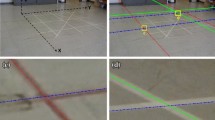Abstract
The human visual system can make remarkably precise spatial judgements. There are reasons to believe that this accuracy is achieved and maintained by using processes that calibrate and correct errors in the system. This work investigate this problem of self-calibration and describes an adaptive system for detecting the collinearity of points and the straightness of lines. The system is initially inaccurate, but, by using an error correction mechanism, it eventually becomes highly accurate. The error correction is performed by a simple self calibration process named proportional multi-gain adjustment. The calibration process adjusts the gain values of the system input units. The process utilizes statistical regularities in the input stimuli. It compensate for errors due to noise in the input units receptive fields location and response functions by ensuring that the average deviation from collinearity offset detected by the system is zero. As a by product of the error correction, the system exhibits also adaptation and aftereffect phenomena, similar to those observed in the human visual system.
Similar content being viewed by others
References
Andrews DP (1964) Error-correction perceptual mechanisms. Q J Exp Psychol 16:104–115
Andrews DP (1967) Perception of contour orientation in the central fovea. part I: short lines. Vision Res 7:975–997
Andrews DP, Butcher AK, Buckley BR (1973) Acuities for spatial arrangement in line figures: human and ideal observers compared. Vision Res 13:599–620
Coltheart M (1971) Visual feature analyzers and aftereffect of tilt and curvature Psychol Rev 78:144–121
Dobbins AM, Zuker SW, Cynader MS (1987) Endstopped neurons in the visual cortex as substrate for calculating curvature Nature 329:438–441
Feller W (1966) An introduction to probability theory and applications, 2nd edn. Wiley, New York London
Gibson JJ (1933) Adaptation, aftereffect and contrast in the perception of curved line. J Exp Psychol 16:1–16
Held R (1980) The rediscovery of adaptability in the visual system: effects of extrinsic and intrinsic chromatic dispersion. In: Harris CS (ed) Visual coding and adaptability, Bell Laboratories, Murray Hill, New Jersey
Kandel ER, Abrams TW, Bernier L, Carew TJ, Hawkins RD, Schwarts JH (1983) Classical condition and sensitization share aspects of the same molecular casade in Aplysia. CSH Symp Quant Biol 48:821–830
Ludvigh E (1953) Direction sense of the eye. Am J Ophthalmol 36:139–143
Nicoll RA, Kaur JA, Malenka RC (1988) The current excitement in long-term potentiation. Neuron 1:97–103
Platt JB (1960) How we see straight lines Sci Am June: 121–129
Rose D, Blakemore C (1974) An analysis of orientation selectivity in the cat's visual cortex. Exp Brain Res 20:1–17
Starton PK, Senjowski TJ (1989) Associative long-term depression in the hippocampus induced by hebian covariance Nature 339:215–218
Ullman S, Schechtman G (1982) Adaptation and gain normalization. Proc R Soc Lond B 216:299–313
Watt RJ (1984) Further evidence concerning the analysis of curvature in human foveal vision. Vision Res 24:251–253
Watt RJ, Andrews DP (1982) Contour curvature analysis: hyperacuities in the discrimination of detailed shape. Vision Res 22:449–460
Welch RB (1974) Research on adaptation to rearrange vision: 1966–1974. Perception 3:367–392
Westheimer G (1981) Visual hyperacuity. Progress in sensory physiology, vol 1. Springer, Berlin Heidelberg New York, pp 1–30
Wilson, H. 1985 Discrimination of contour curvature: data and theory. J Opt Soc Am A 2:1191–1199
Wülfing E (1892) Über den kleinsten Gesichtswinkel. Z Biol 29:199–202
Zipser D, Anderson RA (1988) A back-propagation programmed network that simulates response properties of a subset of posterior partial neurons. Nature 331:679–684
Author information
Authors and Affiliations
Rights and permissions
About this article
Cite this article
Moses, Y., Schechtman, G. & Ullman, S. Self-calibrated collinearity detector. Biol. Cybern. 63, 463–475 (1990). https://doi.org/10.1007/BF00199579
Received:
Accepted:
Issue Date:
DOI: https://doi.org/10.1007/BF00199579




